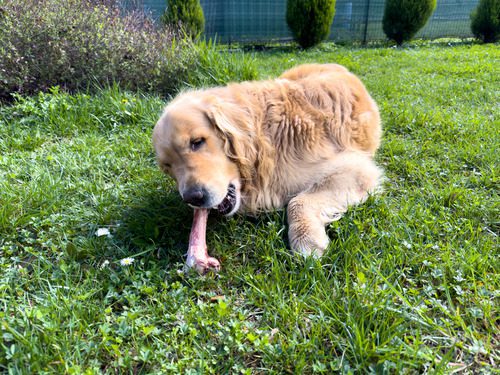What Flea Bites Look Like on Dogs
Do you have a dog? Do you know how to recognize flea bites on your pet? What is the best way to tell the difference between a flea bite on a dog and some other type of bite?
If you’ve ever found yourself asking these kinds of questions, you’re in the right place. In the article below, you’ll find more information to help you narrow down any types of bites that may be present on your dog and determine whether they’re flea bites. With the help of this guide, you can understand when your dog may need treatment for fleas.

Appearance of Flea Bites on Dogs
If your dog is showing any of these signs it would be best to talk with your Heart + Paw veterinarian about the possibility of fleas.
Redness
Redness is one of the earliest symptoms of flea bites on dogs. You may notice your dog has large red welts on their skin, which can indicate that there are fleas. If you have a longhaired dog, however, or a dog with very dark skin, you may be unable to tell from this symptom alone.
Patchy
The red welts from flea bites may look patchy in appearance. They may be uneven around the edges and can be large or small, depending on your dog’s tolerance to the fleas. This patchy appearance may be present in just one location on your dog’s body or may be found across their skin.
Sometimes Raised
In some instances, and especially when dogs are particularly allergic to flea bites, the bites may be raised in appearance. Most of the time, however, they will be flat. A raised flea bite typically indicates that a dog doesn’t have a very high tolerance for fleas.
Many in One Place
Most of the time, flea bites occur in groups and are clustered around certain parts of your dog’s body. This is not always the case, especially in severe flea infestations; however, it is a very common symptom of flea bites. Look for these clusters of bites to help you identify fleas versus some other similar issues.
Other Potential Issues
Talking with your vet is important because sometimes the signs could look like flea bites on your dog, but it could be any of these other things:
Ticks
Tick bites may sometimes look a little bit like flea bites, especially if the tick is no longer attached to the dog’s skin. If the tick is still attached, you can easily identify the cause of the bite. If not, however, look for a red outer ring and a more defined edge to indicate a tick bite instead of a flea bite.
Spiders
Spider bites may also sometimes look like flea bites. However, in many cases, spider bites will be raised and may be filled with pus or fluid. These types of bites are often smaller than flea bites as well.
Ringworm
Ringworm is a large, flat rash with a red ring around its outer edge. It looks similar to some types of tick bites but is quite different in appearance than flea bites. Ringworm also tends to have a scaly texture that is different from the texture of a flea bite, too.
Other Symptoms of Fleas in Dogs
If your dog is showing any of these symptoms or signs be sure to reach out and let your veterinarian know so diagnosis and treatment can begin.
Frequent Scratching
Frequent scratching is typically a telltale sign of fleas in dogs. All dogs scratch now and then, but excessive scratching—especially so much that it breaks the skin—means your dog likely has fleas or some other skin health problem going on. Examine your dog’s skin carefully to see what’s wrong.
Chewing and Licking
Chewing and licking can also mean fleas, especially if your dog’s chewing and licking are excessive and break the skin. These symptoms may also be present with hot spots and other skin health problems, however, so they cannot help you diagnose fleas specifically.
Patchy Hair Loss
Patchy hair loss, once again, may be associated with a variety of problems. However, if your dog is scratching or licking so much that it causes their hair to fall out in spots, this may mean they have a bad flea infestation that needs to be treated as quickly as possible.
Visible Fleas
The best way to tell if your dog’s rash is caused by flea bites is to look for the fleas themselves. On most dogs, you should be able to part the hair and look at your dog’s skin to see fleas moving around on the surface. You may also find flea eggs and larvae on your dog’s bedding.
Call Your Heart + Paw Vet if Your Dog Has Flea Bites
Were you able to learn something useful about recognizing flea bites on your dog? With the help of the information listed above, you should have a better idea of what flea bites look like and how easily they can be confused with other problems, too.
If you notice a concerning bite or other mark on your dog’s skin and you aren’t sure what it might be, talk to your vet for more information. Your Heart + Paw vet can help you determine the cause of the sore or bite and work with you to choose the right treatment as well. Book an appointment online at any of our locations to talk with your vet today!
Recent Posts
Can Dogs Eat Ham?
Ham is a popular meat found on many dinner tables, especially during the holidays. As a dog…
8 Signs and Symptoms of Diabetes in Dogs
Caring for a dog means being tuned in to the subtle changes that can reveal their overall…
Why Dogs Can’t Eat Chocolate and Tips for Keeping This Sweet Treat Out of Their Reach
Chocolate is a beloved indulgence for us, but for our dogs, it’s a hidden danger that can…
Why Cat Teeth Cleaning is Important For Your Pet’s Health
As a cat owner, you know how important it is to care for your feline friend’s overall…
Cat Body Language: A Guide To Understand What Your Cat is Telling You
Imagine trying to communicate without words, relying solely on subtle gestures, glances, and movements. This is how…
About Us
Heart + Paw was founded in 2018 by Chief Veterinary Officer Dr. George Melillo, who currently serves the Mid-Atlantic area. Heart + Paw offers a combination of veterinary care, pet grooming, and dog daycare to help be a resource in your pet parenthood journey.
We'd Love to Meet Your Four-Legged Friends
Find out how the friendly veterinary team at your local Heart + Paw can help your pets live longer, healthier lives by searching for a location near you.





